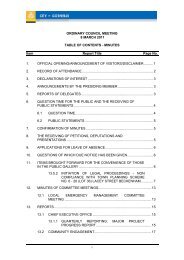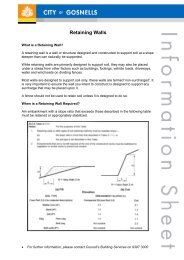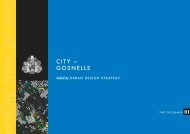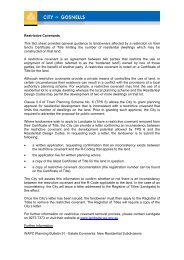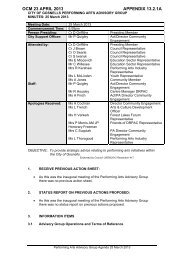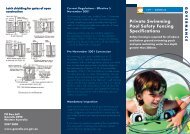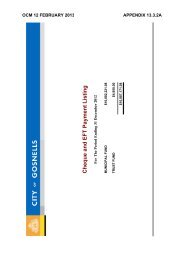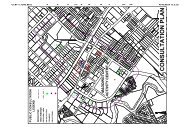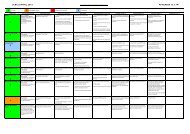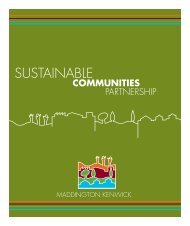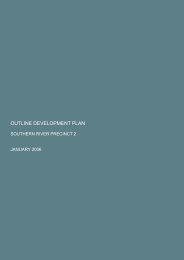Regional Setting 7mapped as clayey sand <strong>of</strong> the Guildford Formation (Sc). In the lower catchment <strong>of</strong> Yule Brook, southwest <strong>of</strong>Brixton St (and below about 7m AHD) the clayey sand (Sc) was mapped as grading into GuildfordFormation sandy clay (Cs). The same sandy clay (Cs) was also mapped over much <strong>of</strong> the MKSEA in the areasouth <strong>of</strong> Victoria Rd (in the lower catchment <strong>of</strong> Bickley Brook). [Note the term ‘mud’, as defined in Section3.3 below, is equivalent to the term ‘clay’ as used in Jordan (1986).]The Deep Bassendean Sands (S8) unit is mapped by Jordan (1986) as prevalent in the east <strong>of</strong> the MKSEA.However, the Guildford Formation underlying this area was evident in several areas where sandy clay (S10)was exposed in slightly lower lying areas amongst the dunes. The dune sands (S8) extended to the yellowsand <strong>of</strong> the Ridge Hill Shelf (S12) at an elevation <strong>of</strong> about 26 m AHD at the eastern boundary <strong>of</strong> theMKSEA, south <strong>of</strong> Victoria Rd. Apart from these dunes in the east <strong>of</strong> the MKSEA, there was a roughlycircular, quartz sand dune (S8) at the corner <strong>of</strong> Bickley and Victoria Rds and two low, linear sand ridges (S8)in the centre <strong>of</strong> the Greater Brixton Street Wetlands between Brook and Boundary Rds.A small basin <strong>of</strong> peaty sand (Sp1) was mapped by Jordan (1986) at the base <strong>of</strong> one <strong>of</strong> the low sand ridges atthe corner <strong>of</strong> Boundary and Bickley Rds. Peaty sediments were not recorded elsewhere in the MKSEA or theGreater Brixton Street Wetlands (Jordan, 1986; V & C Semeniuk Research Group, 2001). This occurrencewas, therefore, unusual for this area.The MKSEA and BFS 387 are located in an alluvial fan complex (V & C Semeniuk Research Group, 2001).This is evident in the topography <strong>of</strong> the area; it is a series <strong>of</strong> flat to gently undulating alluvial terraces(floodplains and palusplains) that gently grade down to the Canning River and are dissected by Yule Brookand its tributaries (Figure 7). The regional stratigraphy in this system is linked to the geographic position inthe landscape (V & C Semeniuk Research Group, 2001) as the structure <strong>of</strong> the alluvial fan has been createdby the gradation from a large to small sedimentary load and gradation from coarse to fine sediments withincreasing distance from the Darling Scarp. This gradation can be seen superficially in the soils (Jordan,1986) (Figure 6) where the finest soils (Cs) <strong>of</strong> the area are distributed in the downslope, western areas <strong>of</strong>BFS 387. The stratigraphic style <strong>of</strong> the various zones <strong>of</strong> the alluvial fan also has implications with regard tothe characteristic hydrological processes that operate in each <strong>of</strong> these zones along this gradient (V. Semeniukpers. comm.). The variation in habitat in the BFS 387 and the MKSEA (topography, soils, stratigraphy andhydrology) is reflected in the subtle variation in vegetation assemblages that have been noted as occurringalong the topographical gradient from east to west in the Greater Brixton Street Wetlands (Goble-Garratt,1991). Thus, the alluvial fan complex can be seen as a series <strong>of</strong> habitat zones created by the variation in thephysical environment along the topographical gradient (Figures 6, 7). The habitat zones created by thevariation in the physical environment along the topographical gradient <strong>of</strong> the alluvial fan complex in WattleGrove-Kenwick-Maddington are important features that underlie the resilience, connectivity andsustainability <strong>of</strong> the biodiversity values in the area and should be considered with regard to the conservationvalues and the management opportunities in the area.Table 2.2: Soils <strong>of</strong> the MKSEA (adapted from Jordan, 1986)Soil unit Descriptors applicable to soil unit LandformSand over sandy clay(Qpb/Qpa: S10)Shallow (Pleistocene) Bassendean Sands overPleistocene alluvium <strong>of</strong> the Guildford FormationPalusplain (Pinjarra Plain) at 10-14 m AHDapprox.Sandy silt (Qha: Ms4) Holocene alluvium Valley floor <strong>of</strong> Yule BrookClayey sand (Qpa: Sc)Sandy clay (Qpa: Cs)Deep BassendeanSands (Qpb: S8)Sand (Qpr: S12)Pleistocene alluvium <strong>of</strong> the Guildford FormationPleistocene alluvium <strong>of</strong> the Guildford FormationDeep (Pleistocene) Bassendean SandsStructure-less yellow sands <strong>of</strong> the YoganupFormationPalusplain-floodplain (Pinjarra Plain)
Regional Setting 82.4 Hydrology and WetlandsThe hydrology and wetlands issues in the MKSEA and the Greater Brixton Street Wetlands are complex andintegral to the conservation <strong>of</strong> the important biodiversity values <strong>of</strong> the area. However, many <strong>of</strong> these issuesare not fully understood by regulators and stakeholders and, hence, are poorly managed. Important issues inthe area include the relationships between the topography, stratigraphy and hydrology in the local alluvialfan system; the impact <strong>of</strong> changes in the hydrological cycle that have been brought about by existingdevelopment on the Yule Brook – Bickley Brook catchments; the relationship <strong>of</strong> the local wetlands to theSwan-Canning Rivers system; the hydrological interactions between the MKSEA and the Greater BrixtonStreet Wetlands (BFS 387); the mapping, classification and management category <strong>of</strong> the wetlands andunusual wetland types in the area; and artificial drainage and stormwater management issues involved inpotential further development.The MKSEA and the Greater Brixton Street Wetlands are located between Yule Brook and Bickley Brook, ashort distance upstream from where these two watercourses drain into the Canning River (Figure 6). YuleBrook traverses the northern precinct <strong>of</strong> the MKSEA. Downstream from the MKSEA, Woodlupine Brookand Binley Brook converge with Yule Brook before it discharges into the Canning River.The groundwater in the vicinity <strong>of</strong> the MKSEA has been mapped in the Perth Groundwater Atlas (2004) at ascale <strong>of</strong> 1:20,000. Although the wetlands <strong>of</strong> the MKSEA, the Greater Brixton Street Wetlands and theClifford Street Bush Forever Site (BFS 53) have been mapped as discrete areas, it is important to understandthat most <strong>of</strong> them are a part <strong>of</strong> a continuous, extensive wetland ecosystem in which the individualcomponents are connected by groundwater flow, subsurface water flows along impermeable layers andchannelled surface water flows (V & C Semeniuk Research Group, 2001; Perth Groundwater Atlas, 2004).The groundwater from the MKSEA discharges to the southwest, through the Greater Brixton Street Wetlandsand downslope towards the Canning River. The groundwater contour lines in the area between Yule Brookand Bickley Brook (that includes the MKSEA and the Greater Brixton Street Wetlands) are orientated almostparallel to the surface topography contour lines (Figures 6, 7).The wetlands <strong>of</strong> the MKSEA were classified and mapped at a scale <strong>of</strong> 1:25,000 by Hill et al. (1996), andthese data are stored and updated in the Swan Coastal Plain Wetland Dataset <strong>of</strong> the Western AustralianDepartment <strong>of</strong> Environment and Conservation (DEC, 2008b). The wetlands in the vicinity <strong>of</strong> the GreaterBrixton Street Wetlands and the MKSEA are part <strong>of</strong> the Keysbrook (P.1) and the Mungala (B/P.2)Consanguineous Wetland Suites (Hill et al., 1996, Volume 2A, Figure 4.4). The occurrence in Kenwick <strong>of</strong>the Keysbrook Consanguineous Wetland Suite is notable as it is the most northerly area <strong>of</strong> this suite. Thereare currently about 70 wetland areas (palusplains, sumplands and damplands) within the MKSEA that havebeen identified and mapped in the SCP Wetland Dataset <strong>of</strong> the Western Australian Department <strong>of</strong>Environment and Conservation (DEC, 2008b). Many <strong>of</strong> the wetlands in the MKSEA that have been mappedin the SCP Wetland Dataset have been assessed as Conservation Category Wetlands (CCW) or ResourceEnhancement Wetlands (REW). There is a group <strong>of</strong> wetlands in the area known as the Greater Brixton StreetWetlands (that corresponds with Bush Forever Site 387) that are <strong>of</strong> very high conservation value and havebeen listed on the Register <strong>of</strong> the National Estate (Government <strong>of</strong> Western Australia, 2000).The fine-scale stratigraphic and hydrological study <strong>of</strong> the Greater Brixton Street Wetlands carried out by theV & C Semeniuk Research Group (2001) provides a basis for understanding the relationship between thenative vegetation <strong>of</strong> the area and its habitat and the long term hydrological regime <strong>of</strong> the area prior toanthropogenic modification. In this study, a ground and surface water monitoring system (at a scaleappropriate to the environmental water requirements <strong>of</strong> the vegetation <strong>of</strong> the area) was establishedthroughout the Greater Brixton Street Wetlands.The complex natural hydrogeology <strong>of</strong> the area is over-printed by a grid <strong>of</strong> excavated drainage channels,firebreaks and tracks. V & C Semeniuk Research Group (2001) found that these soil disturbances caninfluence the hydrological variables <strong>of</strong> the area (such as soil moisture, depth to groundwater and surfacedrainage patterns) during the wet season. The initial conclusions and hydrological managementrecommendations from the study <strong>of</strong> V & C Semeniuk Research Group (2001) were released in 2001, but themonitoring <strong>of</strong> some <strong>of</strong> the bores in this system is ongoing.Tauss, C. and Weston, A.S. (2010). The flora, vegetation and wetlands <strong>of</strong> the Maddington-Kenwick Strategic Employment Area.A survey <strong>of</strong> the rural lands in the vicinity <strong>of</strong> the Greater Brixton Street Wetlands. Report to the <strong>City</strong> <strong>of</strong> <strong>Gosnells</strong>, W.A. Version 18.04.10



